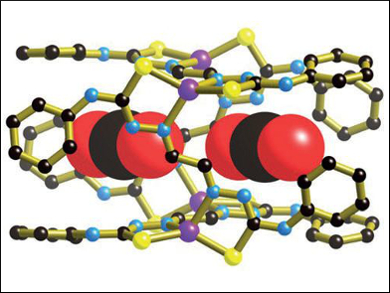Supramolecular architectures with one-dimensional channels, known as “nanotubes”, have potential applications in gas sorption, separation, and storage. Brett Paterson, Brendan Abrahams, Paul Donnelly, and colleagues, University of Melbourne, Australia, have prepared two supramolecular Zn(II) complexes of glyoxal-bis(4-phenyl-3-thiosemicarbazone) (H2gtsp) from the same individual components by changing the conditions of their assembly.
When the material was prepared in the solvent dimethylsulfoxide (DMSO), a trimer triangular prism formed, involving three zinc centers and three bridging ligands. In contrast, discrete tetrameric square coordination nanotubes with four zinc centers bridged by four ligands were formed by simply adding the small molecules acetonitrile, CO2, or CS2. The linear molecules serve to template the formation of the larger tetrameric square coordination nanotubes and are included as guests within the channels. The template can be removed and the hollow nanotubes can adsorb two molecules of CO2 (pictured).
This study demonstrates the use of complementary host–guest relationships to control the assembly of coordination nanotubes, which are capable of acting as hosts for small molecules and could be of use in selective molecular recognition and capture.
- Guest-induced Assembly of Bis(thiosemicarbazonato) Zinc(II) Coordination Nanotubes,
Brett M. Paterson, Keith F. White, Jonathan M. White, Brendan F. Abrahams, Paul S. Donnelly,
Angew. Chem. Int. Ed. 2017.
DOI: 10.1002/anie.201701596




